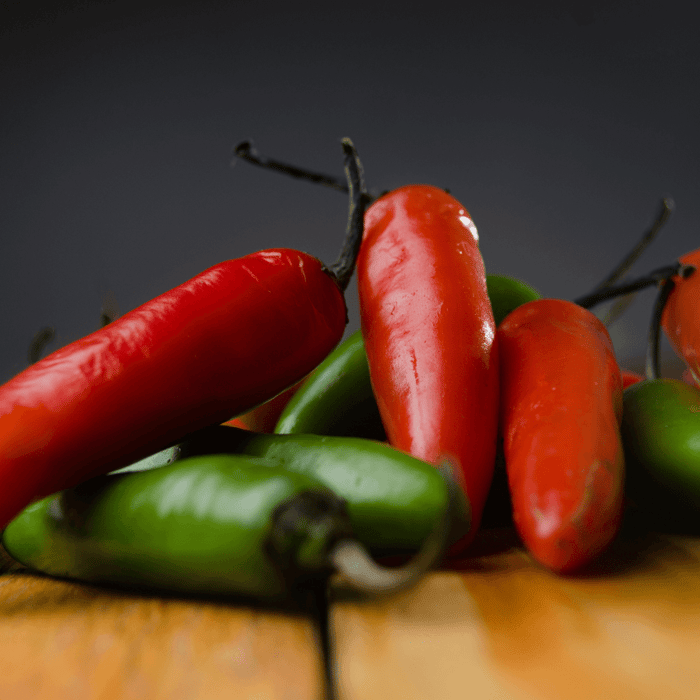Serrano peppers are a popular choice for gardeners looking to add a bit of spice to their pepper garden. These hot pepper plants, native to the mountainous regions of Mexico, are part of the Capsicum annuum family. They offer a pleasant heat level, making them versatile in various dishes. In this article, we'll walk you through a step-by-step guide on how to grow serrano peppers from seeds, ensuring you can enjoy an abundant harvest.
Not only do serrano peppers pack a flavorful punch, but they also provide an array of health benefits. Rich in vitamins A and C, potassium, and antioxidants, these peppers are nutritious for any diet. By growing serrano peppers in your garden, you can ensure your plants are free from harmful chemicals and pesticides, making them an even healthier option. Furthermore, cultivating serrano peppers is an excellent way to diversify your gardening skills and broaden your culinary horizons. With proper care and attention, you'll soon enjoy the fruits of your labor as you savor the taste of homegrown serrano peppers in your favorite recipes.
Table of Contents:
- Understanding Serrano Pepper Characteristics
- Preparing Your Serrano Seeds
- Starting Your Seeds Indoors
- Transplanting Serrano Pepper Plants
- Caring for Your Serrano Plants
- Harvesting Serrano Peppers
- Common Pests and Diseases
- Companion Planting for Serrano Peppers
Understanding Serrano Pepper Characteristics
Before diving into growing serrano peppers from seeds, it's essential to have a solid understanding of the plant's characteristics. This will help you make the best decisions for your pepper plantings.
- Native: Mexico
- Family: Solanaceae
- Genus: Capsicum
- Common Name: Serrano pepper
- History of the Seed: Used by indigenous people in Mexico for centuries
- Days till Maturity: 75-80 days
- Planting Depth: 1/4 inch deep
- Plant Spacing: 18 inches apart
- Days to Germination: 7-14 days
- Indoors or Direct Sown: Indoors
- Full Sun or Partial Shade: Full sun
- When to Harvest: When peppers turn from green to red, yellow, or orange
- Plant Height: 24-36 inches
- Plant Width: 18-24 inches
Serrano Pepper Seeds
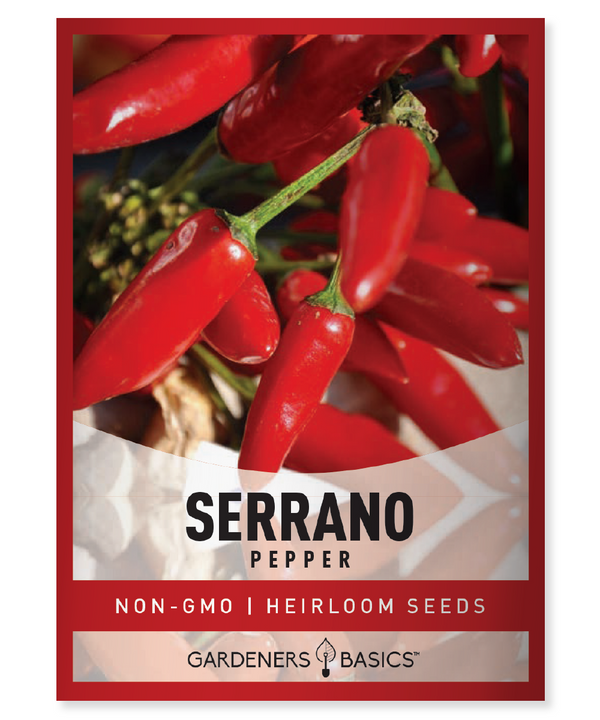
$2.49
Serrano Pepper Seeds – Heirloom, Non-GMO, Non-Hybrid, Open-Pollinated – Perfect for Spicy Gardens Looking to add some heat and flavor to your garden? Our Serrano Pepper seeds are the ultimate choice for pepper enthusiasts. These premium seeds are heirloom, non-GMO,… read more
Preparing Your Serrano Seeds
To start your serrano pepper seeds, you'll first need to acquire high-quality serrano pepper seeds from a reputable source, such as gardenersbasics.com. Once you have your heirloom pepper seeds, you can prepare them for planting by following these steps:
- Soak the seeds: Soaking the serrano seeds in water for 2-4 hours can help speed up germination. This process softens the seed coat and encourages the seed to sprout.
- Prepare seed trays or pots: Fill seed trays or small pots with a seed-starting mix, ensuring the mixture is slightly acidic with a pH between 6.0 and 6.5. This will create an optimal environment for your serrano plants to grow.
- Plant seeds: Plant serrano pepper seeds 1/4 inch deep, following the recommended planting depth. Space seeds at least an inch apart to allow for proper growth.
Starting Your Seeds Indoors
Serrano pepper plants require a long growing season, so starting your seeds indoors 6-8 weeks before your last frost date is best. This will give your plants a head start and ensure they have enough time to reach full size. To start your seeds indoors, follow these steps:
- Place seed trays or pots in a warm location: Position your seed trays or pots in an area with a consistent temperature of 75-85°F (24-29°C). Using a heat mat can help maintain this temperature and promote faster germination.
- Provide ample light: Serrano pepper seeds need plenty of light to germinate and grow. Place the trays or pots near a sunny windowsill or use artificial grow lights, providing at least 14-16 hours of sunshine daily.
- Keep the soil moist: Water the seedlings gently to avoid disturbing the seeds, keeping the soil consistently moist but not soggy. Overwatering can lead to diseases and inhibit growth, so be cautious not to drown your seedlings.
- Wait for germination: Serrano seeds typically germinate within 7-14 days. Once the seedlings have emerged and have developed their first set of true leaves, they're ready to be transplanted.
Transplanting Serrano Pepper Plants
Before transplanting your serrano plants outdoors, you must harden them off. This process acclimatizes the plants to outdoor conditions, reducing the risk of transplant shock. To harden off your serrano plants, follow these steps:
- Gradually expose plants to outdoor conditions: Begin by placing your seedlings outdoors in a protected area for a few hours each day, gradually increasing the exposure over 7-10 days. Be sure to bring the plants inside if temperatures drop below 50°F (10°C) or if there's a risk of frost.
- Choose the right location: Select a planting site in your pepper garden that receives full sun for at least 6-8 hours daily. Serrano plants thrive in well-draining, slightly acidic soil with a pH between 6.0 and 6.5.
- Space plants appropriately: When transplanting serrano pepper plants, space them 18 inches apart to allow for proper air circulation and growth. Rows should be spaced 24-36 inches apart.
- Water after transplanting: Water your serrano plants thoroughly to help them establish their roots and settle into their new environment.
Caring for Your Serrano Plants
Proper care is essential for the success of your serrano pepper plantings. Follow these guidelines to ensure a healthy and productive growing season:
- Water consistently: Serrano plants require consistent moisture, especially as they begin to produce fruit. Aim for 1-2 inches of water per week through rainfall or supplemental irrigation. Be sure to water deeply and allow the soil to dry slightly between waterings.
- Fertilize regularly: Apply a balanced vegetable fertilizer every 4-6 weeks to promote healthy growth and fruit production. Be careful not to over-fertilize, as excessive nitrogen can lead to excessive foliage and reduced fruit production. Fertilizing serrano pepper plants is crucial for fruit production.
- Prune as needed: Pruning your serrano plants can encourage bushier growth and increase pepper production. Remove any damaged or diseased leaves and branches, and consider pinching back the tips of the plant to promote branching.
Pepper Seed Assortment | 8 Variety Pack
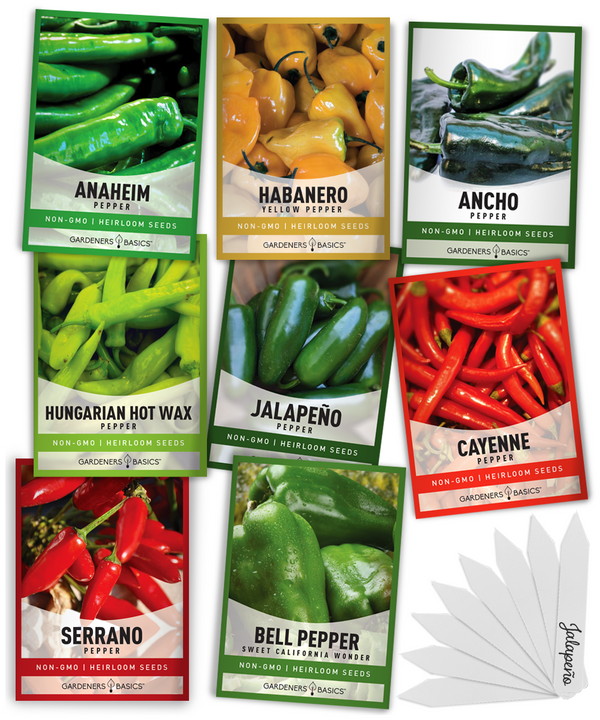
$15.95
8 Pepper Seeds Variety Pack – Heirloom, Non-GMO, Open-Pollinated, Non-Hybrid Seeds Elevate your garden with our 8 Pepper Seeds Variety Pack! This premium selection includes a mix of heirloom, open-pollinated, non-hybrid, non-GMO pepper seeds, perfect for beginner and experienced gardeners.… read more
Harvesting Serrano Peppers
Serrano peppers typically reach maturity in 75-80 days. However, the exact time it takes for your peppers to ripen can depend on factors such as your area's growing conditions and climate. Harvesting serrano peppers at the right time is essential for optimal flavor and heat and ensuring a continued, productive yield from your plants.
When serrano peppers first appear, they will be green in color. As they mature, they'll change to their final color, red, yellow, or orange, depending on the variety. It's important to monitor your plants closely during the ripening stage. Harvesting the peppers at their peak color will give you the best flavor and heat intensity. Remember that allowing the peppers to ripen fully on the plant can increase their heat level, so if you prefer a milder taste, you may want to harvest them earlier. To harvest the peppers, use scissors or pruning shears to cut the stem about an inch above the pepper, ensuring you don't damage the plant. Regularly harvesting ripe peppers will encourage your plants to produce more fruit throughout the growing season, maximizing your overall yield. Follow these guidelines for a successful harvest:
- Monitor color change: Serrano peppers are ready to harvest when they change from green to red, yellow, or orange. The exact color will depend on the variety you're growing.
- Use scissors or pruners: To avoid damaging the plant, use scissors or pruners to cut the stem of the pepper rather than pulling it off by hand. Leave a small portion of the stem attached to the pepper to help prolong its freshness.
- Harvest regularly: Regular harvesting encourages your serrano plants to produce more peppers. Check your plants frequently and harvest ripe peppers to make room for new growth.
Common Pests and Diseases of Serrano Peppers
Serrano pepper plants can be affected by various pests and diseases. Keep an eye out for these common issues and address them promptly to prevent damage to your plants:
Aphids
These small, soft-bodied insects can cause leaves to curl and stunt plant growth. They feed on plant sap, leading to a weakened plant and the potential transmission of plant viruses. Use insecticidal soap or neem oil to control aphids. Additionally, you can introduce beneficial insects such as ladybugs and lacewings, which are natural predators of aphids.
Spider mites
Tiny mites create webbing on the undersides of leaves, leading to leaf discoloration and eventual leaf drop. They feed on the plant's sap, causing the leaves to lose their chlorophyll and turn yellow or bronze. Use a strong spray of water to dislodge mites, being sure to target the undersides of the leaves. You can also treat your plants with insecticidal soap or neem oil. Regularly monitoring your plants and addressing infestations early on will help keep these pests under control.
Bacterial spot
This disease causes small, water-soaked spots on leaves and fruit that can later develop into necrotic lesions. Bacterial spots can stunt plant growth and reduce pepper yields. To prevent bacterial spots, use disease-resistant varieties, practice crop rotation, and avoid overhead watering, which can spread the bacteria. Remove any infected plant material and consider applying a copper-based fungicide to help control the disease.
Companion Planting for Serrano Peppers Plants
Companion planting can benefit your serrano pepper plants by improving soil health, deterring pests, and attracting beneficial insects. Consider planting these beneficial companions near your serrano plants:
Basil
This herb is believed to improve the flavor of peppers and can help repel pests like aphids and spider mites. Planting basil alongside your serrano plants can create a natural barrier against these pests while providing a delicious and versatile herb in your kitchen.
Onions
Planting onions near your serrano plants can help deter pests like aphids and mites. Onions release a strong scent that is believed to confuse and repel these pests. Additionally, onions can help suppress weeds, which can compete with your pepper plants for nutrients and water.
Marigolds
These vibrant flowers repel various pests, including nematodes, which can damage pepper plants' roots. Marigolds release a toxic chemical to nematodes, helping protect your serrano plants. In addition to their pest-repelling properties, marigolds can add visual interest to your pepper garden and attract pollinators like bees and butterflies.
However, avoid planting fennel or kohlrabi near your serrano plants, as they can stunt pepper growth and inhibit fruit production. Fennel releases a chemical that can hinder the growth of many plants, while kohlrabi can compete with your serrano plants for space and nutrients. Keep these plants in separate areas of your garden to ensure the best growth for your serrano peppers.
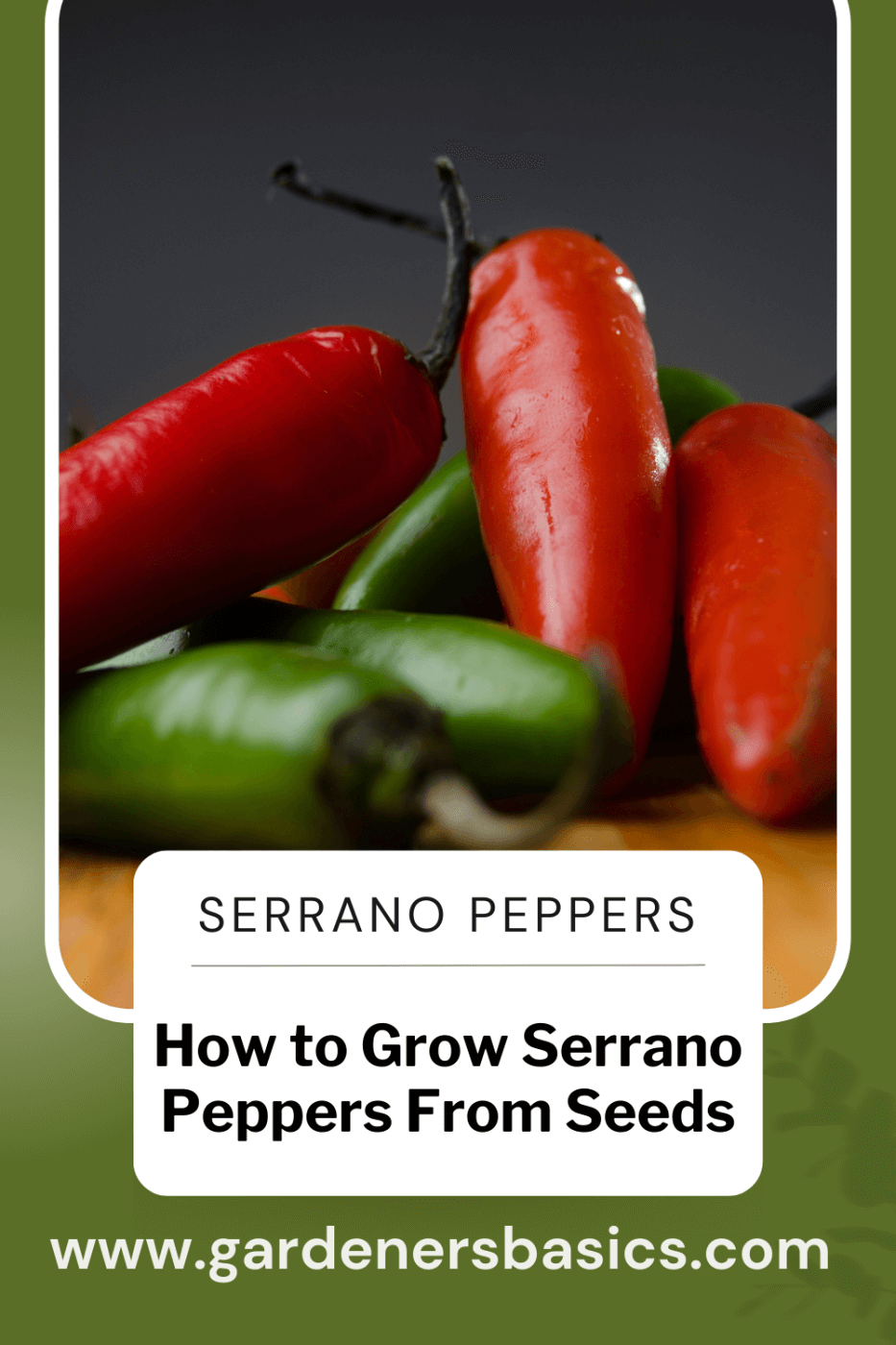 Frequently Asked Questions - How to Grow Serrano Peppers from Seeds
Frequently Asked Questions - How to Grow Serrano Peppers from Seeds
Q: How long does it take for serrano peppers to grow from seed?
A: Serrano peppers typically take 75-80 days to mature when transplanted outdoors. It's best to start the seeds indoors 6-8 weeks before the last frost date to ensure a full growing season.
Q: Can I grow serrano peppers in containers?
A: Yes, you can grow serrano peppers in containers. Choose a container at least 12 inches in diameter with drainage holes. Be sure to use a well-draining, slightly acidic potting mix and provide the plants with plenty of sunlight and consistent moisture.
Q: When should I transplant serrano pepper seedlings outdoors?
A: Transplant your serrano pepper seedlings outdoors after the risk of frost has passed, and nighttime temperatures consistently stay above 50°F (10°C). Be sure to harden off the seedlings for 7-10 days before transplanting to help them acclimate to outdoor conditions.
Seed Safe Survival Seed Kit - 35 Variety Pack
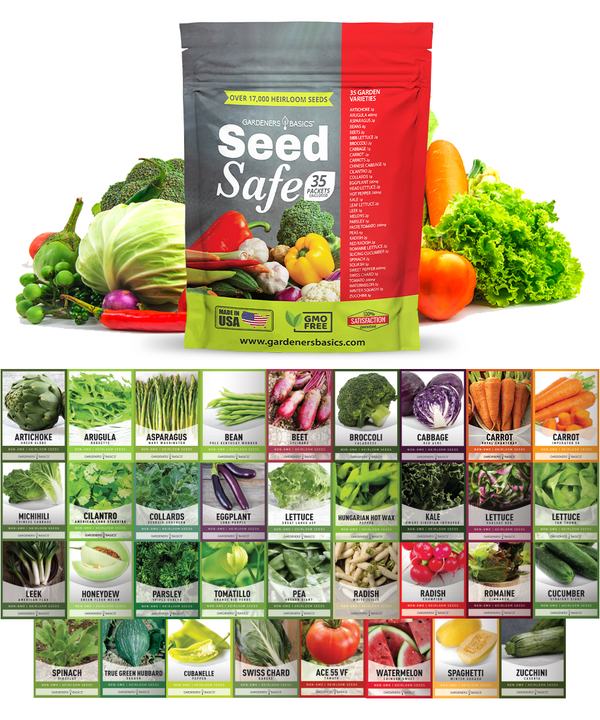
$29.95
$49.95
Seed Safe Survival Seed Kit: The Ultimate Heirloom Collection for Self-Sufficient Gardening Introducing the Seed Safe - 35 Varieties of Heirloom Vegetable, Herb, and Fruit Seeds, the ultimate solution for gardeners who want to secure a bountiful future harvest. This… read more
Q: How often should I water my serrano pepper plants?
A: Aim to provide your serrano plants with 1-2 inches of water per week through rainfall or supplemental irrigation. Water deeply and allow the soil to dry slightly between waterings to prevent overwatering and root rot.
Q: How can I tell when my serrano peppers are ready to harvest?
A: Serrano peppers are ready to harvest when they change color from green to red, yellow, or orange, depending on the variety. Harvesting serrano peppers regularly will encourage your plants to produce more fruit.
More Tips for Growing Serrano Peppers
To ensure success in your serrano pepper garden, consider these additional tips and tricks:
Q: How can I increase the heat level of my serrano peppers?
A: The heat level of serrano peppers can be influenced by environmental factors. Allowing the soil to dry out slightly between waterings and providing your plants with consistent sunlight can help increase the heat of your peppers. However, remember that genetics play a significant role in determining the heat level of your peppers, so results may vary.
Q: Can I save seeds from my serrano peppers to plant next year?
A: You can save seeds from your serrano peppers to plant in the following growing season. Allow a few of your best peppers to fully ripen on the plant, then harvest them and remove the seeds. Dry the seeds thoroughly and store them in a cool, dry place until you're ready to plant them.
Q: How can I prevent pests and diseases in my serrano pepper plants?
A: Practice good garden hygiene to prevent pests and diseases in your serrano pepper garden. Remove plant debris, fallen fruit, and weeds that harbor pests or diseases. Rotate your pepper crops every 2-3 years to help prevent the buildup of soil-borne diseases. Additionally, row covers can help protect your plants from pests while allowing light and air to circulate.
Q: Can I grow serrano peppers from store-bought peppers?
A: While growing serrano peppers from seeds collected from store-bought peppers is possible, the results may not be as consistent as using seeds from a reputable source. Store-bought peppers may be hybrids, resulting in plants with different characteristics than the parent plant. To ensure the best results, purchase high-quality serrano pepper seeds from a trusted source like gardenersbasics.com.
By following this comprehensive guide and addressing any potential questions, you'll be well on your way to a successful Serrano pepper garden. With time, patience, and care, your serrano pepper plants will reward you with a bountiful harvest of spicy, flavorful peppers to enjoy in your favorite dishes.



